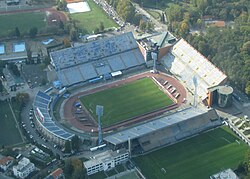 Aerial View | |
 | |
| Full name | Maksimir Stadium |
|---|---|
| Location | Maksimir, Zagreb, Croatia |
| Coordinates | 45°49′8″N 16°1′5″E / 45.81889°N 16.01806°E |
| Operator | GNK Dinamo Zagreb |
| Capacity | 25,912 (interim)[1] |
| Record attendance | 64,138 (NK Zagreb vs NK Osijek, 19 July 1973) |
| Field size | 105 m × 68 m (344 ft × 223 ft) |
| Surface | Hybrid grass |
| Construction | |
| Opened | 5 May 1912 |
| Renovated | 1948, 1998, 2011 |
| Architect | Vladimir Turina, Branko Kincl |
| Tenants | |
| HAŠK (1912–1945) HŠK Građanski (1912–1924) GNK Dinamo Zagreb (1948–present) ŽNK Dinamo Zagreb (selected matches) Croatia national football team (1990–present) NK Lokomotiva (2009–2017) | |
Maksimir Stadium (Croatian: Stadion Maksimir, pronounced [ˈstâdioːn mǎksimiːr]) is a multi-use stadium in Zagreb, Croatia. Named after the surrounding neighbourhood of Maksimir, it is one of the largest stadiums in the country with a current seating capacity of 25,912 and a maximum possible capacity of 35,423. It is the home stadium of Croatian club Dinamo Zagreb and has been used since 1990 by the Croatia national football team for the majority of international competitions.
Built 112 years ago in 1912, the stadium underwent renovations in 1948, 1998, and 2011. Its facilities can be converted into a concert stage which has been used to host musical acts.
Maksimir Stadium has four stands: north, east, west, and south, with all seats seated, and no standing places for spectators in the stadium.
A major renovation of the stadium in June 2011 saw new seats installed, and a greater distance created between seats.
Due to the strong earthquake that struck Zagreb on March 22, 2020, the east stand has not been open to spectators.[2]
- ^ "Stadion - Dinamo Zagreb". gnkdinamo.hr. Archived from the original on 30 July 2017. Retrieved 9 May 2018.
- ^ "Stadium | Dinamo Zagreb". gnkdinamo.hr. Retrieved 2023-11-27.